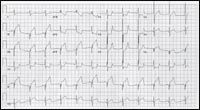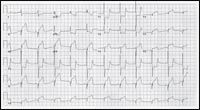- Clinical Technology
- Adult Immunization
- Hepatology
- Pediatric Immunization
- Screening
- Psychiatry
- Allergy
- Women's Health
- Cardiology
- Pediatrics
- Dermatology
- Endocrinology
- Pain Management
- Gastroenterology
- Infectious Disease
- Obesity Medicine
- Rheumatology
- Nephrology
- Neurology
- Pulmonology
Inferior Myocardial Infarction With Right Ventricular Involvement
Right Ventricular involvement in acute inferior MI is an independent predictor of major complications and in-hospital death, as this case demonstrates. While in-hospital prognosis after left ventricular infarction is directly related to the postinfarct LV ejection fraction, involvement of the right ventricle drastically alters that linear relationship.
A 32-year-old man is brought to the emergency department (ED) with severe substernal chest pain of 20 minutes' duration and associated dyspnea, left arm numbness, diaphoresis, and nausea. During the previous 24 hours, he had multiple episodes of light-headedness and shortness of breath that occurred at rest and resolved quickly without intervention. When he arrived at work, chest pain developed in addition to the light-headedness and dyspnea; these symptoms persisted and the pain worsened.
The patient has hypertension, which is treated with metoprolol and lisinopril. He smokes tobacco regularly. Several paternal relatives had myocardial infarctions (MIs) between 50 and 60 years of age.

Figure 1 – The initial ECG shows normal sinus rhythm with Q waves and ST-segment elevation in leads II, III, and aVF, and ST-segment depression in leads I, aVL, and V1 through V
3
. These findings are consistent with an inferior wall myocardial infarction.
En route to the ED, the patient was given four 81-mg aspirin tablets and two 0.4-mg sublingual nitroglycerin tablets. On arrival, he is awake, diaphoretic, and pale. Temperature is 36.7°C (98.1°F); blood pressure, 60/36 mm Hg; heart rate, 70 beats per minute; respiration rate, 16 breaths per minute; and oxygen saturation, 98% on 3 L of oxygen by nasal cannula. His skin is cool and clammy. Heart rhythm is regular with no murmurs, rubs, or gallops. No jugular venous distention is noted. Lungs are clear. Abdomen is soft, nontender, and without evidence of hepatomegaly. Extremities are cool without cyanosis or edema. Peripheral pulses are weak but palpable. Head, neck, and neurological examination results are normal.
The initial ECG shows normal sinus rhythm with Q waves and STsegment elevation in leads II, III, and aVF, and ST-segment depression in leads I, aVL, and V1 through V3 (Figure 1). An ECG with rightsided precordial leads shows Q waves and ST elevation in V4R through V6R (Figure 2).
A portable chest radiograph reveals that the mediastinum and heart are of normal size, with no evidence of pulmonary edema or infiltrate.
The patient is given a rapid bolus of 2 L of normal saline, and his blood pressure rises to 113/53 mm Hg. He also receives a bolus of unfractionated heparin followed by a continuous heparin infusion. His blood pressure remains in the range of 110/50 to 120/60 mm Hg. Additional nitroglycerin is not required. Acute inferior wall MI with right ventricular (RV) involvement is diagnosed, and primary percutaneous coronary intervention (PCI) is scheduled.
INFERIOR WALL MI WITH RV INVOLVEMENT

Figure 2 – This ECG with the precordial leads switched to the right side of the chest shows Q waves and ST elevation in V
4
R through V
6
R. These findings are consistent with right ventricular infarction.
Overview. Blood supply to the inferior wall of the left ventricle may come from either the left circumflex artery or the right coronary artery (RCA).1 About 85% of the general population is termed "right dominant," meaning that the RCA provides a posterior descending artery branch to supply the inferior wall of the left ventricle. About 8% of the population is "left dominant": the left circumflex artery provides the posterior descending artery. The remaining population is "codominant": the blood supply is shared. Because of variations in blood supply to the inferior wall, ischemia in that region may be associated with left ventricular (LV) lateral ischemia or RV ischemia.
On a traditional 12-lead ECG, ischemic changes can be grouped together to help localize the insult to various regions of the left ventricle in the following manner:
Infarction of the right ventricle and the LV basal region are not readily shown as ST-segment elevations on the traditional 12-lead ECG. A right-sided ECG with supplemental leads V3R through V6R may be used to examine activity of the RV free wall, and supplemental leads V7 through V9 may be used to examine activity of the LV basal region. Because most persons are right dominant, 35% to 50% of inferior MIs involve the right ventricle.2
Diagnosis. Patients with RV MIs may not present with classic symptoms. They are less likely to present with dyspnea than patients who have inferior MI without RV involvement (36% vs 68%) and are more likely to present with syncope (20% vs 6.7%).3
Inferior wall infarction on an initial ECG, manifested as ST-segment elevations in leads II, III, and aVF, should prompt further investigation for evidence of RV involvement (see Figure 1). On a right-sided ECG with leads V3R through V6R, a 0.1 mV or greater ST-segment elevation in V4R has been shown to predict RV MI with an overall sensitivity of 88%, a specificity of 78%, and an accuracy of 83%4 (see Figure 2). Although less reliable, ST-segment depression of 1 mm or greater in lead aVL in patients with evidence of inferior MI has also been associated with RV involvement.5
Implications for prognosis. RV involvement in acute inferior MI is an independent predictor of major complications and in-hospital mortality3,4 as well as long-term morbidity.4,6 While in-hospital prognosis after LV infarction is directly related to the postinfarct LV ejection fraction, involvement of the right ventricle drastically alters that linear relationship because of the regions supplied specifically by the RCA (Table).7
RV MI leads to reduced RV filling, which translates into poor LV preload regardless of the amount of preserved LV systolic function. In addition, ischemia to the conduction pathways disrupts the normal rate and rhythm control to the entire heart. High-degree atrioventricular blocks have been reported in 50% of patients who have inferior MI with RV involvement, compared with 13% of those without RV involvement.2
The combination of reduced preload and disruption of the normal cardiac conduction pathway results in a high degree of complications. In the era of revascularization via thrombolysis, overall in-hospital mortality for patients with RV MI is 31%, compared with 6% for patients with inferior MI without RV involvement. RV involvement in inferior MI is associated with a significantly higher incidence of major complications during hospital stay, including cardiogenic shock, atrioventricular block, pacing requirement, and ventricular fibrillation.3,4 After discharge, RV involvement in inferior MI is independently predictive of the need for permanent pacing within 3 years of follow-up.4
Even in the era of PCI, RV involvement in acute inferior MI is still an independent marker for increased mortality.6 Despite a similar rate of procedural success, patients with RV MI have an overall higher rate of in-hospital major adverse events (15%) than patients with anterior or inferior MI (5% to 8%). Furthermore, infarction involving the right ventricle is associated with a 5-fold increase in 30-day mortality.
Management. The incidence of cardiogenic shock on presentation in patients with inferior MI is about 11%.4 Oxygenation should be optimized with supplemental oxygen, and intravenous access should be obtained with 2 large-bore catheters in anticipation of the possible requirement of a large volume of fluid.
Obtain an ECG as soon as possible. If a pattern of inferior infarction is found, obtain a second ECG with right-sided leads V3R through V6R to look for evidence of RV MI. The initial ECG should also be examined for any evidence of atrioventricular block and significant bradycardia. An antiplatelet agent should be given, and the patient should be assessed for any contraindications to anticoagulation.
The mainstay of treatment is immediate revascularization, preferably by primary PCI. Complete revascularization of the RCA, including its major arterial branches, has been associated with a more favorable outcome. Reperfusion of the main RCA as well as all the RV and LV branches, when compared with reperfusion of only the main RCA and its branches to the left ventricle, has been associated with better RV function recovery (67% vs 32%) and lower 30-day mortality (3.9% vs 23%).6
Two aspects of RV MI therapy differ from treatment of LV infarcts. First, because of the loss of RV function, about 33% to 50% of patients present with inadequate LV preload.7 Unlike the low-output hypotension pattern of LV infarction with associated pulmonary venous congestion, which requires judicious use of small volumes of fluid, the hypotension in RV infarction resulting from inadequate LV preload may require large volumes of fluids for support. Nitrates, which are potent venous dilating agents used traditionally to alleviate chest symptoms, should be avoided to prevent any further drop in preload and cardiac output.
Second, given the role of the RCA in supporting the cardiac conduction pathway, inotropic and chronotropic dysfunction may require intervention.7 If large volumes of fluid have been given without significant improvement in symptomatic hypotension, inotropic support may be initiated with dobutamine to optimize cardiac contractility to improve output. If symptomatic sinus bradycardia is present, intravenous atropine may be necessary. If symptomatic bradycardia is associated with atrioventricular node blockade, transcutaneous pacing may be necessary to maintain adequate cardiac output.
Nodal blocking agents, such as β-blockers, should be used cautiously. If a patient is tachycardic without ECG evidence of nodal dysfunction, β-blockers should not be withheld. However, any evidence of highdegree atrioventricular block precludes the use of such agents.
OUTCOME OF THIS CASE
Cardiac catheterization revealed an 80% stenosis of the proximal RCA. The culprit lesion was irregular and laden with acute thrombus. Also visible were emboli in the distal posterior descending artery and the distal posterolateral branch. The thrombus was removed, followed by angioplasty and placement of a bare metal stent in the proximal RCA. An echocardiogram on the following day showed severe hypokinesis of the entire inferior wall of the left ventricle extending into the apex and a LV ejection fraction of 50%.
The patient was discharged with prescriptions for clopidogrel, aspirin, lisinopril, metoprolol, and atorvastatin, and follow-up with cardiac rehabilitation services was scheduled.
References:
REFERENCES:1. Wellens HJ. Right ventricular infarction. N Engl J Med 1993;328:1036-1038.
2. Braat SH, de Zwaan C, Brugada P, et al. Right ventricular involvement with acute inferior wall myocardial infarction identifies high risk of developing atrioventricular nodal conduction disturbances. Am Heart J. 1984;107:1183-1187.
3. Chockalingam A, Gnanavelu G, Subramaniam T, et al. Right ventricular myocardial infarction: presentation and acute outcomes. Angiology. 2005; 56:371-376.
4. Zehender M, Kasper W, Kauder E, et al. Right ventricular infarctions as an independent predictor of prognosis after acute inferior myocardial infarction. N Engl J Med. 1993;328:981-988.
5. Turhan H, Yilmaz MB, Yetkin E, et al. Diagnostic value of aVL derivation for right ventricular involvement in patients with acute inferior myocardial infarction. Ann Noninvasive Electrocardiol. 2003;8: 185-188.
6. Assali AR, Teplitsky I, Ben-Dor I, et al. Prognostic importance of right ventricular infarction in an acute myocardial infarction cohort referred for contemporary percutaneous reperfusion therapy. Am Heart J. 2007;153:231-237.
7. Horan LG, Flowers NC. Right ventricular infarction: specific requirements of management. Am Fam Physician. 1999;60:1727-1734.
